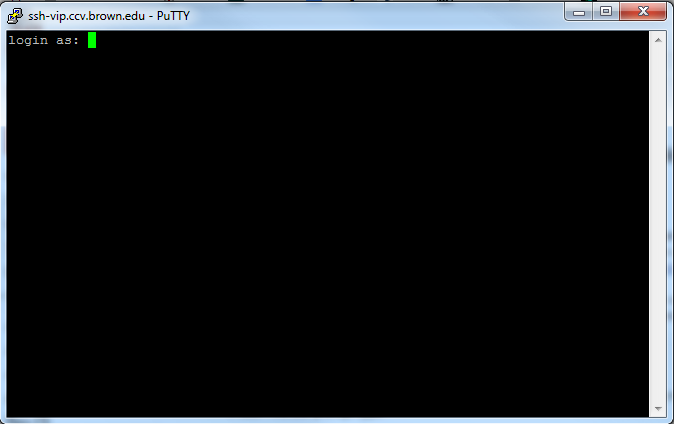For Linux and Mac users, accessing oscar is relatively simple; open a terminal window and type:
ssh -Y username@ssh.ccv.brown.edu
where username is your user name. Enter your password and you' read to go.
For Windows users, life is tougher. Windows doesn't have a built in ssh client. ssh is a network protocol for accessing remote systems. An ssh client is the program that runs on your computer and manages teh communication with a remote host. There are a number of ssh clients for Windows. A few are listed here.
CCV recommends PuTTY as the ssh client for Windows. You can download PuTTY from here. Besides PuTTY, you should download PSCP.
Here's how to get started with putty. I assume you downloaded it and put in some directory on your windows machine.
Double click it to start it.
In the Host Name box, type: ssh.ccv.brown.edu
Make sure Port is set to 22 and SSH button is checked
Click on the box next to connections in the window on the left to expand it. Click on the box next to SSH to expand the tree.
Click on X11, click the Enable X11 Forwarding box.
Click on Session in the window on the left to go back to the original screen.
In the box below Saved Sessions, type oscar and click the Save button. This will save your setup so you don't have to type all this stuff. Next time, just click on oscar in The Saved Sessions list and click Load.
Now, click the Open button. You should get a window that looks like a Windows CMD window.
Enter your password at the password prompt. You should see something like this:
You will probably see text that differs somewhat, but you should see a prompt something like username@oscar and a cursor waiting for you to enter something.
Now for the fun part. You're on Linux and operating remotely, so it's different than Windows. You will mostly be working from the command line. There are a number of tutorials on the web about Linux. Here are a few: http://www.ee.surrey.ac.uk/
There are several text editors, matlab, firefox, tons of other stuff available on oscar. Best to read through one of the tutorials to get a feeling for some simple commands. Linux is powerful, but the command line can take a little getting used to if you're a windows type person.
When you are done, type exit in the oscar window.
Transferring Files
Linux and Mac users can transfer files from their computer to oscar using scp. Open a terminal window and type:
scp README.txt thompson@ssh.ccv.brown.edu:/users/thompson
Windows users use PSCP to transfer files to oscar from your computer. Open a windows cmd window. Change to the directory containing PSCP. At the prompt type:
pscp README.txt thompson@ssh.ccv.brown.edu:/
README.txt is just the name of some file you want to transfer to oscar and change the "thompson" stuff to your user name. The third picture below shows an example. The file will be in your home directory (that's the one you're in when you log into oscar) on oscar.
An alternative that I like is to use FileZilla. It's pretty intuitive to use and runs on Windows, Mac, and Linux. You can drag and drop files to and from the remote host to your computer.
Alternative Ways to access oscar
This shows VNC running Matlab and a terminal window on oscar.
The VNC client is convenient. The only problem that I have with it is that copy and paste between VNC and your local computer doesn't work due to a bug.







No comments:
Post a Comment